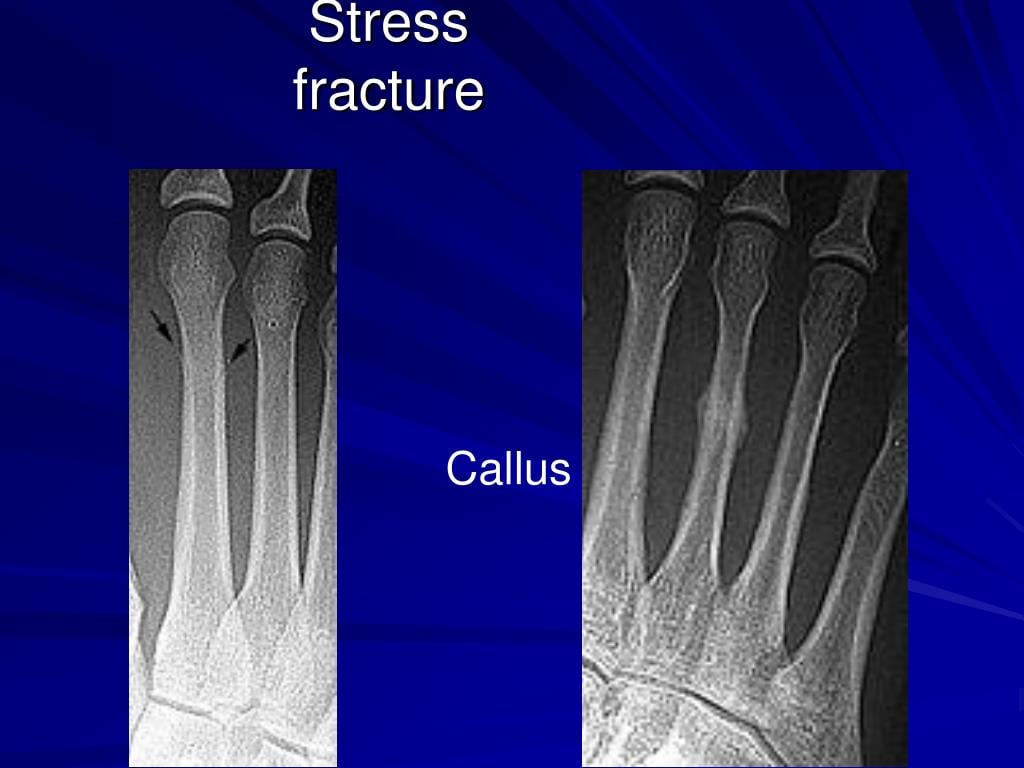By Brian Hoke
Pushing our limits is one of the primary means by which we achieve higher levels of fitness and athletic performance. We are rewarded for our persistent efforts by strengthening our muscles and raising our level of cardiovascular and muscular endurance. Unfortunately, the cost of our dedicated effort can also be a serious injury to the bones that support us.
A stress fracture is a breakdown of the inner structure of a bone. The essential cause is that the forces sustained by this area are exceeding the capacity of the tissues to bear the load. There is pain when weight or stress is placed on the bone, and it is very tender to the touch.
Stages of A Stress Fracture:
- The first stages of this bone damage are microscopic, so they do not show up on an x-ray in the first few weeks.
- After several more weeks, the body sends additional calcium to the area to heal the bone and an x-ray will show this thickened area (see photo below).
- An MRI or specialized x-ray called a bone scan can sometimes show the stress fracture before it is visible on a traditional x-ray.

Understanding how stress fractures happen may help you lower your risk of incurring such an injury. It has been my experience that stress fractures typically happen to highly motivated people. These injuries are frequently the result of the “three toos”: too much, too fast, and too soon.
“Too much” refers to training schedules that create high cumulative loads on the bone that causes it to fail. “Too fast” refers to increases in the exercise load too quickly, as in someone who runs 10 miles a week and then the next week tries to run 20 miles. “Too soon” is starting exercises at too high of an initial level. I find that there are two types of athletes that frequently make this mistake. One is the novice athlete who wants to become more fit but starts at a level their body cannot tolerate. The other is the experienced athlete who is coming back after an injury. The seasoned athlete knows their body has been able to tolerate high levels of exercise in the past, but they try to jump back into a routine too quickly at a level that aggravates the newly healed tissues.
Reducing Your Risk of Stress Fractures:
- Gradual Changes to Your Exercise Time: to reduce the risk of stress fractures, the central concept is incremental advancement in training. Research has shown that an increase of exercise duration of 10% per week is a generally safe level for most people.
- Nutrition: nutritional factors can also play a role in reducing stress fracture risk such as ensuring that there are adequate levels of calcium and vitamin D in the diet. Sunlight is also integral to Vitamin D production, but of course caution should also be taken to avoid overexposure.
- Cross Training: activities such as running and cycling involve doing the same motion over and over hundreds of times in every workout. This repetitive stress can ultimately lead to a stress fracture. It’s similar to the analogy of breaking a metal coat hanger by bending it back and forth in the same spot over and over. Your bone is injured the same way. We can break up this potentially damaging pattern by integrating different modes of exercise in our weekly routine. This changes the pattern of repetitive loading on our bones and reduces our risk of a stress fracture.
- Quality Footwear: stress fractures in the legs can be related to foot structure and selecting the right shoe for your foot type can assist in balancing pressure and forces. In general, if you have a stiff high arched foot, you need a shoe with more cushioning in the midsole layer. Those with flexible low arches need to have more supportive footwear with an insole that closely matches the natural shape of the foot. Custom insoles (orthotics) can also play a role in balancing the forces on the foot and steering the foot into a more neutral pattern of loading.
Don’t Pay the Price:
When a stress fracture occurs, it is like any other broken bone, and it needs time to heal properly. The individual who develops a stress fracture needs to avoid the urge to jump back too quickly into the same situation that caused the injury.
About the Author:
Specializing in orthopedic and sports physical therapy, Brian Hoke, DPT, SCS has a particular interest in the biomechanical factors influencing lower limb rehabilitation. He is co-owner and director of Atlantic Physical Therapy, a private practice in Virginia Beach, VA.
Brian is a board certified Clinical Specialist in Sports Physical Therapy, a distinction achieved by fewer than 600 physical therapists in the U.S. He works with athletes of all levels—from recreational runners to elite professional and Olympic athletes. He has contributed chapters to two textbooks on the treatment of running injuries.
Brian is an avid educator, lecturing extensively in the U.S. and internationally. Since 1985, he has been a faculty member of the popular continuing medical education seminar, “When the Feet Hit the Ground, Everything Changes.” He co-developed and has taught the “Take the Next Step” course since 1990. In addition, he has been an adjunct faculty member of physical therapy programs at Old Dominion University and Touro College on Long Island, NY.
Brian’s expertise in sports physical therapy is a particular asset to Vionic’s athletic line of footwear. He and Phillip Vasyli have also collaborated to create a foot orthotic designed for problems with supination—when feet roll outward too much.

Leave a Reply